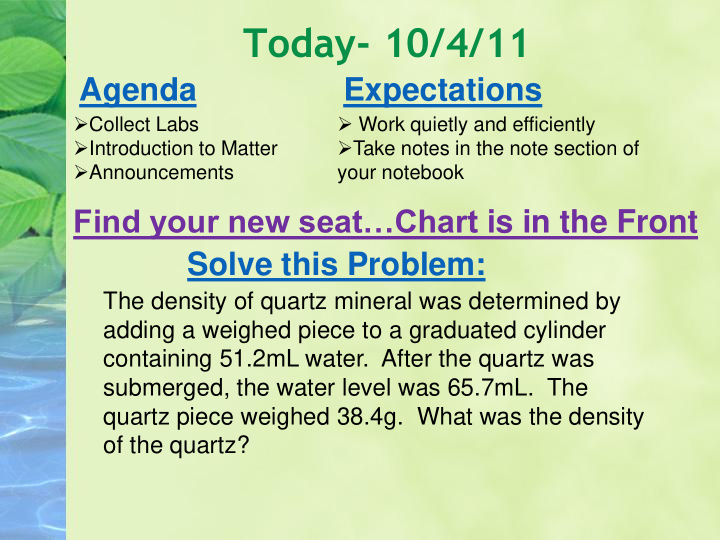



Today- 10/4/11 Agenda Expectations Collect Labs Work quietly and efficiently Introduction to Matter Take notes in the note section of Announcements your notebook Find your new seat…Chart is in the Front Solve this Problem: The density of quartz mineral was determined by adding a weighed piece to a graduated cylinder containing 51.2mL water. After the quartz was submerged, the water level was 65.7mL. The quartz piece weighed 38.4g. What was the density of the quartz?
Matter
Standard 5 Understand the structure of an atom in terms of its subatomic particles; isotopes and ions; differentiate between the classification and separation of matter (mixtures, pure substances…)
Matter Matter: Anything that has mass and takes up space.
Atoms Building blocks of matter. Contains subatomic particles: Electrons Neutrons Protons
Subatomic Particles Protons and electrons are the only particles that have a charge. Protons and neutrons have essentially the same mass. The mass of an electron is so small we ignore it.
Symbols of Elements Resulting Charge Mass number (number of protons plus neutrons) C 12 Symbol of the Element 6 Atomic number (number of protons) Elements are symbolized by one or two letters.
Atomic Number Resulting Charge Mass number (number of protons plus neutrons) C 12 Symbol of the Element 6 Atomic number (number of protons) All atoms of the same element have the same number of protons
Atomic Mass Resulting Charge Mass number (number of protons plus neutrons) C 12 Symbol of the Element 6 Atomic number (number of protons) The mass of an atom in atomic mass units (amu) is the total number of protons and neutrons in the atom.
Determining Electrons Resulting Charge Mass number (number of protons plus neutrons) C 12 Symbol of the Element 6 Atomic number (number of protons) In elements the # of protons = the # of electrons, so the element is electrically neutral and no charge is shown . However atoms can gain or lose electrons to become ions and the resulting charge is shown.
Isotopes • Atoms of the same element with different masses. • Isotopes have different numbers of neutrons. 11 12 13 14 C C C C 6 6 6 6
Practice Symbol # of # of # of Net Protons Neutrons Electrons Charge 115 I n 49 79 3+ 17 16 74 2- 8 75 As 36 33
States of Matter Deposition Sublimation
Classification of Matter
Classification of Matter
Classification of Matter
Classification of Matter
Classification of Matter
Classification of Matter
Classification of Matter
Classification of Matter
Classification of Matter
Classification of Matter
Properties and Changes of Matter
Properties of Matter • Physical Properties: □ Can be observed without changing a substance into another substance. • Boiling point, density, mass, volume, etc. • Chemical Properties: □ Can only be observed when a substance is changed into another substance. • Flammability, corrosiveness, reactivity with acid, etc.
Changes of Matter • Physical Changes: □ Changes in matter that do not change the composition of a substance. • Changes of state, temperature, volume, etc. • Chemical Changes: □ Changes that result in new substances. • Combustion, oxidation, decomposition, etc.
Chemical Reactions In the course of a chemical reaction, the reacting substances are converted to new substances.
Chemical Separation of Matter Electrolysis Compounds can be broken down into more elemental particles.
Physical Separation of Mixtures
Distillation: Separates homogeneous mixture on the basis of differences in boiling point.
Filtration: Separates solid substances from liquids and solutions.
Chromatography: Separates substances on the basis of differences in solubility in a solvent.
Recommend
More recommend